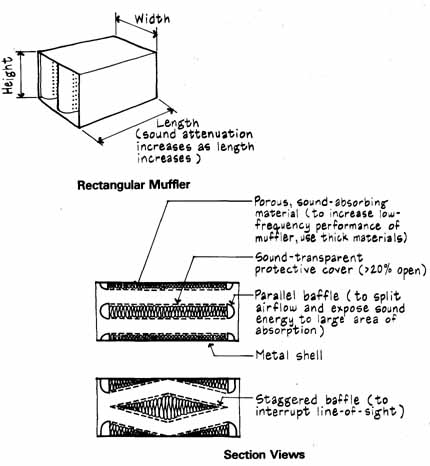AMAZON multi-meters discounts AMAZON oscilloscope discounts
Sound attenuators—also called mufflers, silencers, or sound traps—are prefabricated devices designed to provide much greater sound attenuation over a wider frequency range than would be provided by an equal length of lined duct. They provide greater attenuation because the distance between absorptive layers is much smaller than in a lined duct. Mufflers are normally available in both rectangular and circular cross-sectional shapes with absorptive baffles (or splitters) as shown below.
All-metal mufflers and mufflers with “bagged” linings (i.e., polyethylene- encased fibrous material) can be used in health care and food industry occupancies where exposed fibrous linings could support organic growth of germs. The all-metal mufflers are constructed of perforated baffles with air cavities behind to provide resonant absorption (cf., Journal of the Acoustical Society of America, April 1981, p. 1216). The air cavities, which can be steam cleaned or vacuumed, don't contain fibrous materials to collect dirt and bacteria.
Because attenuation performance varies widely with airflow conditions, al ways refer to manufacturer’s test data for anticipated attenuation performance at the airflow volume and pressure drop design conditions. Example sound- attenuation data for 3-ft-long rectangular mufflers with parallel baffles and staggered baffles are shown below.

Rectangular Muffler; Section Views
Refer to ASTM E 477 test data for the noise generated by the muffler it self (called self-noise). Airflow through mufflers produces aerodynamic sound which may be unacceptable in applications where low background noise levels are essential. Therefore, when controlling fan noise, it's best to locate mufflers near or in the walls of mechanical equipment rooms, or above adjacent non- sensitive spaces (e.g., corridors, storage rooms). Be sure also to provide tapered transitions so that air ducts gradually change shape from duct to muffler. Do not locate mufflers too close to intake or discharge of fans or near elbows.

References
G. J. Sanders, “Silencers: Their Design and Application,” Sound and Vibration, February 1968.
“Testing Duct Liner Materials and Prefabricated Silencers for Acoustical and Airflow Performance,” ASTM E 477.
I. L. V “Prediction Scheme for the Self-Generated Noise of Silencers,” Proceedings of the 1972 National Conference on Noise Control Engineering, Institute of Noise Control Engineering, Poughkeepsie, N.Y., 1972, pp. 294-298.
Next: Lined Plenums
Prev: Glass-Fiber Duct Linings